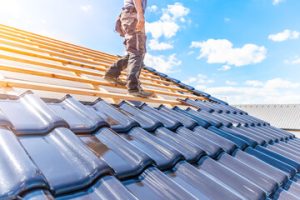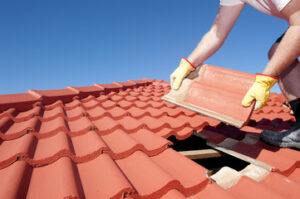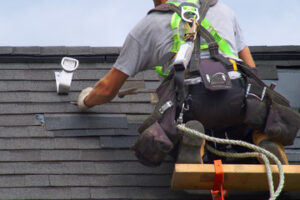Choosing the right roof for your home is a big decision that impacts its lifespan and overall cost. You’ll also need to decide on roofing materials and accessories like vents and ridge vents.

A roof installation is a labor-intensive project. It requires a lot of preparation, including removing the existing roof and installing underlayment. Visit https://www.bostonroofingco.com/ to learn more.
The first step in the roofing installation process is to prepare your home for the project. This includes clearing obstacles and removing vehicles, covering or removing items in the attic, and preparing your yard to protect things like garden beds and air conditioning units. You should also talk to your neighbors about the upcoming work, as debris can fall into their yards as well.
Then, the roofers will remove any roof accessories such as satellite dishes or skylights. They will also clean the existing roof of any moss, algae and other growth that could impact the new coating. Depending on your choice of roof, the contractors will either nail or screw in the shingles. If you’ve chosen asphalt shingles, they will be staggered and nailed in, while metal roofing is screwed in. Finally, the flashing will be installed around chimneys, vents and similar areas to prevent water intrusion.
During this stage, the roofers will also waterproof the valleys, which are the v-shaped areas between slopes that channel rainwater to drainpipes. The underlayment will be placed over the sheathing and nailed in place, with nails closer together at the edges and more spaced out towards the middle. The shingles will then be placed over the underlayment, nailed in and sealed to the sheathing with silicone caulk.
This process will be repeated over the entire roof. The shingle installation is completed with the addition of a starter strip, which is a piece of continuous adhesive that secures the shingle to the sheathing. The starter strip also protects the underside of the shingle from UV damage and helps to keep the seal intact.
The roofing contractors will also install drip edge, which is a protective layer that extends from the bottom of the gutter to the eaves. It’s important to note that some companies may not install this feature, but it is an excellent investment that can help to prolong the life of your roof and your gutter system. You should also ask your roofing contractor about other optional extras that may be available, such as ridge vents and attic insulation.
Materials
The roof is one of the most important parts of a house, shielding it from rain, wind, and other natural elements. It also keeps moisture from entering the home, preventing mold and mildew and contributing to energy efficiency. When it’s time to re-roof, homeowners must choose the materials that will best meet their needs and aesthetic preferences. The cost of roofing materials is an important consideration, but it’s also important to consider longevity and environmental impact.
Different roofing materials require different installation tactics, and it’s crucial that you choose a contractor with the right knowledge and experience to ensure the job is done correctly. A reputable contractor will have references from previous clients and will use industry-standard materials that are backed by warranties. They will also be able to advise you on the pros and cons of different types of roofing materials and the installation process.
For homeowners with flat or low-pitched roofs, membrane roofing is a great choice. It offers excellent protection against water, UV rays, and weather, and can be customized to mimic other styles of roofing. However, it is expensive and requires regular maintenance. If you decide to go with this type of roofing, you’ll want to hire a professional with extensive experience working on flat or low-pitched roofs.
Traditional wood shingles and shakes are popular choices that can give a home a beautiful, rustic look. They are crafted from thin wedges of wood that are precision cut and come in a variety of shades and textures. They are a great choice for homes with natural surroundings and can add a rustic, country charm to any building. However, they are heavier than other roofing options and can be difficult to install and repair.
Asphalt shingles are a standard in many modern homes. They are affordable, easy to install, and offer a range of colors and styles. They are a good option for those looking for a durable and attractive roofing solution.
Installation
A good roofing contractor will cover sensitive parts of your home with tarps, put down a dumpster, and use wooden boards to protect things like your garden and air conditioning unit from debris falling off the roof. The roof tear off will be done with specialized equipment that is designed to minimize the amount of roof material left behind.
Any vents, chimneys, skylights, and other features will be sealed with a bead of roof cement. These areas will also be nailed down with nails that are close together at the edges and more spread out towards the center. Some homeowners choose to re-roof only sections of their roof instead of the whole thing, which can be a budget-friendly solution that still delivers aesthetic cohesion and precise installation.
Final Inspection
A final inspection is the last step in the roofing installation process. During this phase, a professional 3rd party inspector will check the products to make sure they’re of high quality and comply with customs standards. A quality final inspection can save manufacturers from costly rework, compliance issues and product returns.
Ensure the contractor knows what is expected of them before they arrive for the final inspection. This can include things like ensuring all the roof flashings are installed properly, confirming the nailing pattern of the roofing is correct and that there are no gaps in the underlayment. It can also include checking the gutters are in good condition and that all the electrical is up to code.
The building inspector will perform a thorough visual inspection of the structure. This includes walking on the top of the roof, entering the attic and looking at the interior walls. The inspector will also look for signs of sagging or uneven roof planes and examine the condition of the gutter systems, chimneys and masonry. The inspector will also take a walk around the property to make sure all landscaping and outdoor furniture is protected during the construction work and that the driveways, patios and steps are safe for use.
When the inspection is complete, the inspector will prepare an inspection report, sign off on the project and issue a Certificate of Occupancy. A successful certificate of occupancy is proof that the building is safe for habitation and complies with all regulations. If the building fails to pass the final inspection, it will need to undergo further testing and rework.
Building inspections are a crucial part of the construction process, and if they’re not done correctly, it can lead to expensive delays, both financially and logistically depending on when individual certificates were expected/required etc. In order to avoid this, it’s important for contractors involved in the construction of residential homes/commercial buildings/etc to be proactive with regards to adherence to codes throughout each step of the building process; a well-defined pre-purchase inspection and a clear, detailed contract can help to mitigate most issues before they arise, thus reducing overall cost, time and resources for the project.


